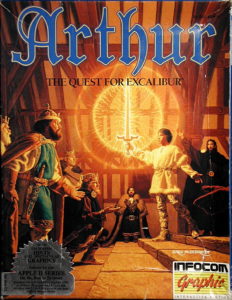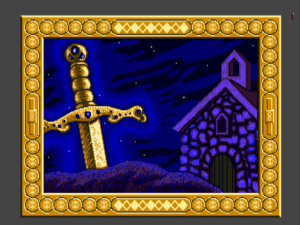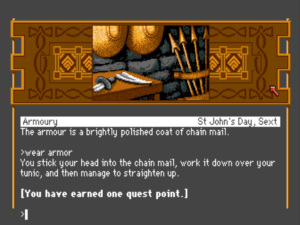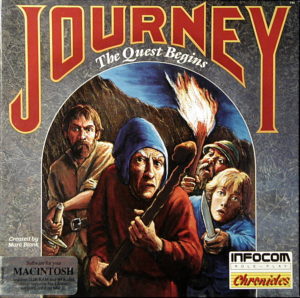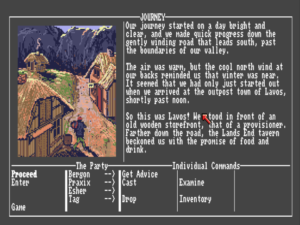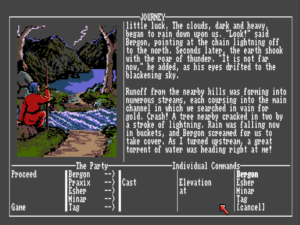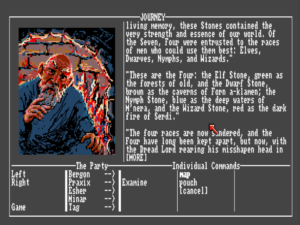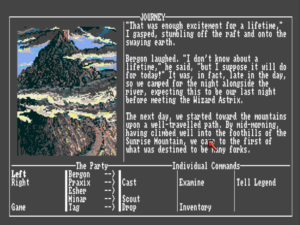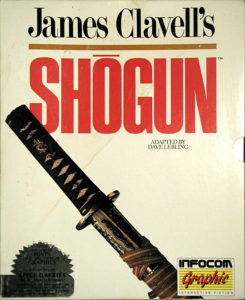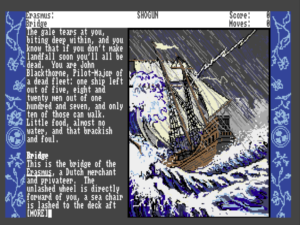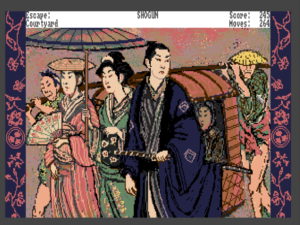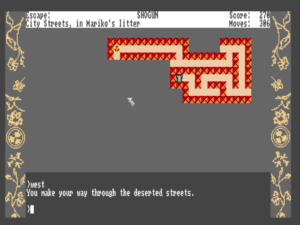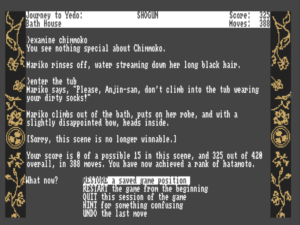The work week of May 1, 1989, started off much like any other inside the beleaguered latter-day Infocom. In the cavernous 18,000 square feet of their office space at 125 CambridgePark Drive — its sheer size was an ever-present reminder of more optimistic times, when Infocom had thought themselves poised to become the next Lotus — the shrunken staff of just 26 souls puttered through another Monday, pausing now and again to chat about the weekend just passed. The old days when CambridgePark would buzz during off-hours with parties and socializing and passionate programmers and testers burning the midnight oil were now a memory of the past. Changing life circumstances — the majority of the remaining staff were now married, many with small children — had done as much as the generalized malaise now afflicting the place to put an end to all that. CambridgePark now felt much like any other office, albeit a peculiarly empty one, and one over which hung an almost palpable sense of impending doom. Still, when the axe finally fell it came as a shock. It always does.
A memo went out early that week asking everyone to attend a meeting on Thursday, May 4, “to discuss the next generation of internal products.” More ominously, the memo said that the 3:00 P.M. meeting would “go as late as necessary.” And evidently management expected that to mean quite late, for they would be “ordering out for dinner.”
The axe fell over the course of that long afternoon and evening. Infocom would be “moving” to California, where it was to be reconstituted and re-imagined as a more closely coupled subsidiary of Mediagenic, [1]Mediagenic was known as Activision until mid-1988. To avoid confusion, I just stick with the name “Mediagenic” in this article. under a “general manager” named Rob Sears. Just 11 of the 26 current employees were offered positions at this new version of Infocom. Exactly whose name was and wasn’t on that list of job offers is neither necessary nor appropriate to discuss here. Suffice to say that those Mediagenic decided were desirable to retain often weren’t the pivotal creative voices you might expect, and that only 5 of the 11 accepted the offer anyway. Only one long-serving employee from Infocom’s glory days would end up making the move: Duncan Blanchard, a longstanding interpreter programmer and the last leader of the old Micro Group before it was assimilated into the Systems Group in 1987. For the other old-timers, it was all over. Another six weeks or so to finish a few final projects and tidy up the place, and that would be that.
Bob Bates, working on his licensed Abyss game from suburban Maryland, had planned to fly up to Cambridge for one of his regular design meetings on Monday, May 8. But Infocom’s new Mediagenic-installed head Joe Ybarra called him early in the week of May 1, saying he really needed him to come up this same week if at all possible. When Bates arrived on Friday, May 5, to a curiously subdued CambridgePark, he was ushered immediately into Ybarra’s office. Infocom was moving to California without most of its current employees, Ybarra informed him, and his Abyss project was being cancelled. Nor would Infocom be requiring Bates’s services again; his development contract was officially terminated as of today. When a shell-shocked Bates returned home on the red eye that same rainy night, he found that his roof was leaking buckets. It had turned into that sort of week for everyone.
Steve Meretzky had been scheduled to attend the Computer Game Developers’ Conference that very weekend in Sunnyvale, California. He was still allowed to fly out on Infocom’s dime, but replaced the company’s name on his badge with “Make Me an Offer!” It was at this event that word of the fate of Infocom, which everyone knew had long been troubled but which still remained one of the most respected names in computer games, was first spread within the industry.
News of Infocom’s fate first reached the world at large via an announcement in the May 22, 1989, issue of the Boston Globe Magazine. The understated headline has become oddly iconic among fans: “Computer-Games Firm Moving to California.” A “new consumer preference for games with graphics and sound,” went the workmanlike report, was responsible for Infocom’s travails, along with Nintendo and “the aging of Infocom’s traditional audience, composed of early computer users who spent evenings and weekends hunched over a terminal drawing maps in text-only games that took 20 to 50 hours to solve.”
When word reached the trade press, Mediagenic held tightly to the story that this was simply a move, not a shutdown. Rob Sears made the counter-intuitive claim that Mediagenic was doing what they were “not so much to close Infocom down as to ensure it survives.” “The Great Underground Empire, curiously enough, has not been shut down,” insisted Joe Ybarra. “What’s happened is we’re in the process of relocating it to the West Coast.” At the same time, though, Ybarra did have to quietly admit that none of the Imps who had built the Great Underground Empire would remain a part of it. He could only offer some unconvincingly vague suggestions that some of the former Imps might “do projects” at some point as outside contractors. Certainly anyone wedded to the idea of Infocom as a maker first and foremost of text adventures was given little reason for hope.
You’ll probably see a shift in direction that’s commensurate with which way the market is headed. If you look at all the successful products, they’re graphics- and sound-intensive. Products as a whole are pushing more toward role-playing than toward our classic adventure game. I think we’ll be building more hybrids that share elements of all these different genres. In particular, one of the areas I find most exciting is getting into more interactive graphics, the idea of doing things that are object-oriented… a cross between Manhole and the HyperCard environment and our traditional object-oriented ZIL environment.
(In case Ybarra’s comments don’t make it clear, know that “object-oriented” was one of the sexiest buzzwords of the period, to be applied to anything and everything possible.)
The personnel inside CambridgePark continued to perform their duties in desultory fashion during those final weeks following the meeting that informed them of their fate. There was still plenty to do; Infocom had still not delivered finalized versions of their four most recent works of graphical interactive fiction for MS-DOS, the most important platform in the industry. Yet there was, understandably, little enthusiasm for doing it. Employees spent a lot of time picking out free games from the collection around the office, bidding on the office furniture and computers, and indulging their black humor via vehicles like a lunchtime “slideshow history of Infocom” entitled “Cornerstone through Tombstone.” And then the last day came, and the lights inside CambridgePark were extinguished forever — or at least until the next corporate tenant arrived.
By the point of that final closure, a considerable amount of back-channel sniping by the people of the former Infocom had begun toward Mediagenic. Not coincidentally, Mediagenic’s own take on recent events also became less sanguine. Sources from Infocom claimed that Mediagenic had pulled the plug just as the money spigots were about to open, just before the all-important MS-DOS versions of their graphical interactive fictions finally hit the market; as it was, these versions would all be released by Mediagenic as un-promoted afterthoughts within weeks of the closure. Mediagenic, for whom Infocom’s slow progress on their MS-DOS interpreter had been a huge frustration and a significant factor in their decision to finally wash their hands of CambridgePark altogether, replied that “the consolidation might not have become necessary if the IBM SKUs could have been released initially.” Likewise, Joe Ybarra’s characterization of the fundamental failings of Infocom’s games grew more pointed: “We cannot continue, in the marketplace, living off products that take eight hours to play well and up to 200 hours to complete.”
The view of the decision of May 4, 1989, that prevails universally today, as representative of a definitive ending rather than a move or consolidation, was already taking hold. Mediagenic stopped giving even lip service to Infocom as an ongoing operation of its own in the spring of 1990, when Rob Sears left and the remaining handful of personnel who had worked under him were either let go or absorbed into the parent company. From now on, Infocom would be a mere label under which Mediagenic would release some of their more narrative-oriented games.
In the long run, the people who had made up the old Infocom would all be just fine. After all, they were one hell of an impressive group, with credentials and talents that made them eminently employable. For those stalwarts in positions of business or creative leadership, who had been forced to bear up under the ever more crushing burden of Infocom’s troubled finances since 1985, the final, sharply definitive ending to it all felt like something of a relief as soon as the shock and pain of the initial announcement had faded.
The majority of the old Infocom staff exited the games industry at the same time that they exited Infocom, never to return. The limited or nonexistent applicability of the skills of some of Infocom’s most essential employees to the games being made by other companies — like, for instance, those of editor, producer, and all-around unsung hero Jon Palace — says much about just how unique Infocom really was. For others, though, the decision to get out of games had more to do with their fatigue with such an eternally tormented and tormenting industry than it did with job opportunities or a lack thereof inside it. Put simply, there are easier ways to make a living than by making computer games, and masterful programmers like Tim Anderson, Dave Lebling, and Stu Galley reckoned they were ready for more ordinary jobs. They and many others like them went on to live happy lives, building good, enjoyable careers that needn’t consume them. But there were also some gluttons for punishment who hadn’t yet burnt out on games. Marc Blank, Steve Meretzky, Mike Berlyn, Brian Moriarty, Mike Dornbrook, and Bob Bates would all be stubborn and passionate enough to remain in the industry. We’ll thus be meeting at least some of them again in future articles.
Seen purely as a business proposition, Infocom had been a colossal, unadulterated failure. Whether as independent company or Mediagenic subsidiary, Infocom never enjoyed a single profitable year after 1983, and its final ledger shows it to be millions in the red over the course of its relatively brief lifetime. But very few of those who had worked there thought of Infocom as a failure in the aftermath of its death — not even those former employees whose jobs had entailed fretting about the endless cavalcade of quarterly and yearly losses.
For some former employees, including many who might have had little to no interest in the company’s actual products, Infocom remains forever in their memories just a really fun office to work in — indeed, the best they could ever imagine. Plenty of these people would be shocked to learn of the aura of awed respect and love that still surrounds the very name of Infocom in the minds of fans today; they never realized they were creating timeless games. Others, of course, including virtually everyone who played a major creative role in making the games, did realize, at least after the fact, that they had done something very special indeed. Some former employees accept the bad decisions and missed opportunities that so frustrate fans peaceably, as karma, fate, or just plain old learning experiences. Others, thankfully a minority, still curse the names of either or both Al Vezza and Bruce Davis, the two great villains of the story, and are intermittently tormented by thoughts of what might have been.
What might have been… it’s a fraught question, isn’t it? Yet it’s a question that we as humans, confronted with something as special and noble as Infocom that seems so self-evidently to have died too soon, can hardly resist asking. The historian in me knows to be very leery of setting off down that road. Still, just this once, coming as we are to the end of the most detailed story I’ve ever told on this blog, maybe we can indulge in a little bit of counter-factualizing.
It seems to me that the first and perhaps most important thing we need to do to come to grips with the might-have-beens that surround Infocom is to separate the company itself from the medium of the text adventure. Such a separation can be weirdly difficult to actually accomplish. Infocom didn’t create the text adventure, nor did the company’s end mark the medium’s end — far from it, as years of articles that are hopefully still to come right here on this site will underline — but the name of Infocom would always remain all but synonymous with the form. Jason Scott has told how, when he was making his Get Lamp documentary about the life and times of the text adventure, he was constantly asked by friends how his “Infocom movie” was coming. At a certain point, he just gave up on correcting them.
Given this close connection, it can be jarring to consider that few to none of the people working at Infocom, even among those who weren’t on Team Cornerstone, thought of their company as an exclusive maker of text adventures. The story of how Infocom first came to make text adventures almost accidentally — that of needing a product to bootstrap their operation, and pulling good old MIT Zork down off the shelf as the fastest way to make one — has of course been well-documented, here and in plenty of other places. But even after they had become identified as makers of the world’s most sophisticated text adventures, they were very reluctant to settle for that niche. A research project into cross-platform graphics was begun already in 1983, at the same time that they were running all those iconic “anti-graphics” advertisements; said advertisements were merely clever promotions, not the expression of an absolute corporate philosophy. In 1984, Mike Berlyn and Marc Blank poured considerable time and effort into another innovative research project that came to naught in the end, a multi-player MUD-like environment to be hosted by the online service CompuServe. The following year brought the multi-player computerized board game Fooblitzky, Infocom’s first graphical product and one of the oddest they ever released. In short, Infocom always had ambitions beyond the text adventure, but those ambitions were consistently crippled by the lack of money for game development that plagued the company beginning as early as 1983, when Cornerstone first began to suck all the oxygen out of the room.
The counter-factual scenario most likely to yield an Infocom that survives beyond the 1980s is, as fan wisdom has long attested, one in which they never start down the Cornerstone wormhole. Yet the same best-case scenario is also possessed of a trait that fans may be less eager to acknowledge: in it, the money not spent on Cornerstone isn’t spent on making ever more elaborate text adventures, but rather on embracing new genres, new paradigms of play. Infocom could quite likely have survived if they’d avoided Cornerstone and made smart business decisions, and the world of gaming would doubtless have been a better place for their tradition of literacy, thoughtfulness, and innovation. But unfortunately, those same smart business decisions would likely have to entail branching out from the text adventure early, and eventually moving on completely. Dave Lebling:
I think in terms of continuing to produce the kind of thing we had been producing — i.e., text adventures with lots of cool technology to make them more realistic, lots of plot value, etc. — we could have gone on forever. I’m less sure whether the market would have continued to buy those. We had big arguments about this even before the Mediagenic/Activision acquisition. If you’ve spent several thousand dollars for a computer with a color screen and a video card and you want to display lots of pretty pictures, are you going to settle for a text adventure?
In my opinion, that was sort of a minority taste, just like reading is somewhat of a minority taste. People would much rather look at pictures than read as a rule. There’s a subculture of people who love to read, who are passionate about reading, passionate about books, but it’s not the majority of the public. The same thing is true in computers. There are people who like pictures and action and so forth, and there are people who like reading. And again, they are a minority.
So, I don’t think Infocom could have continued to go on from strength to strength the way we seemed to have been doing initially; we would have plateaued out. I think we eventually would have had to branch out into other kinds of games ourselves. The advantage would have been that we would have decided what to do, rather than some other company.
For proof of Lebling’s assertions, we need only look to what happened in the broader computer-game industry of our own timeline during the mid- to late-1980s. In 1984, at the height of the bookware frenzy, at least a dozen publishers in the United States alone could lay claim to major initiatives in the realm of text adventures, a medium that, being in most people’s mind the ultimate anti-action game, seemed the perfect fit for post-Great Videogame Crash electronic entertainment. Every single one of those initiatives, excepting only the games Infocom released that year, disappointed to one degree or another. To imagine that a counter-factual Infocom — even one with the resources to improve their technology, to offer even bigger and better games than the ones we know, to include pictures and interface conveniences years before the Infocom of our own timeline — could have continued to buck the trend for very long seems a stretch. And indeed, many of Infocom’s financial travails, which began already in 1985 when a subtle but worrisome sales slowdown on the part of many of their games first became evident alongside the obvious disaster that was Cornerstone, had far more to do with the wider market for text adventures than it did with Cornerstone. Put another way: if their games business had continued to explode as it had in 1983 and 1984, Infocom could have weathered the storm of Cornerstone’s failure bruised but solvent. It was a perfect storm, a combination of their slackening games business and the fiasco that was Cornerstone, that cast them into Mediagenic’s arms in 1986.
So, to understand the reasons for Infocom’s collapse we need to ask why it was that the bookware boom, during which they were the shining example to be emulated by all those other publishers, so comprehensively failed to meet expectations. I think there are two reasons really, involving two D-words I tend to dwell on a lot around here: Demographics and Design.
Simply put, the games industry of the mid- to late-1980s wasn’t populated by enough readers to sustain a vibrant culture of commercial text adventures. The overwhelming computer-game demographic by 1985 was teenage boys, who have never been known as a terribly thoughtful group. The dominance enjoyed by text adventures during the earlier years of the decade owed much to the fact that computer gaming was a much more exclusive hobby during that period, practiced only by those with a restless bent of mind and the financial resources to invest thousands of dollars in an object as ultimately useless as an early microcomputer for the home. Mike Dornbrook and others involved with Infocom near the beginning have often mentioned their wonder at the sheer number of doctors and lawyers on their mailing lists. The demographics of gaming began to change with the arrival of the inexpensive Commodore 64 as a major market force in 1983. Within the next year or two, it remade the entire industry in its image — and most definitely not to the text adventure’s benefit.
At the same time that this demographic shift was underway, Infocom and the various bookware bandwagon jumpers were allowing themselves to become confused about the reasons for the text adventure’s ascendancy even among the relatively cerebral home-computer constituency of the early 1980s. Companies making text adventures in those early days can be divided into two groups: those like Sierra who were working in text because nothing else was practical at the time, and those like Infocom who saw the text adventure as a worthy new ludic and/or literary form unto itself. Sierra got away from text adventures just as soon as they could, and went on to become one of the biggest and most important game publishers of the 1990s. Infocom stuck with the form, and we know what happened to them. There is I think a lesson to be found therein. Infocom craved a sort of player who didn’t exist in the numbers they believed them to even in the early years, and who came to make up a smaller and smaller percentage of the gaming public as time went by. By 1987, some of Infocom’s experiments were aimed at a computer-game customer who was all but nonexistent: like a fan of New Yorker-style verbal wit in the case of Nord and Bert Couldn’t Make Head or Tail of It, or a romance-novel fan in the case of Plundered Hearts.
A tantalizing question must be whether a healthier Infocom could have created a market for such games among non-gaming, possibly non-computer-owning lovers of books and puzzles. Clearly their games did have appeal to some well outside of the typical computer-game demographic. Infocom during their halcyon days had enjoyed glowing write-ups in such places as the Boston Globe, the New York Times Review of Books, Discovery magazine, and even Rolling Stone. Still, the fact remained that their games threw up tremendous barriers to entry, beginning with the sheer cost of the equipment needed to run them and ending with the learning curve for interacting with them. While it’s tempting to imagine a world of interactive fiction existing entirely outside the rest of the games industry with its bash-and-crash take on existence — a world where literary sophisticates pick up a copy of the latest Infocom release from a kiosk in a trendy bookstore — it’s hard to imagine even a healthy Infocom creating such a milieu from scratch. It’s also doubtful, for that matter, whether most of their precious remaining base of customers really wanted to see them moving in that direction. The Infocom games that are most notable for their literary ambition, like A Mind Forever Voyaging and Trinity, were never among their biggest sellers. A substantial percentage of their customer base, as various Imps have wryly noted over the years, would have been quite happy if Infocom had churned out nothing but endless iterations on the original Zork. It was at least as much the Imps’ own creative restlessness as it was the need to serve the market that led them to dabble in so many different literary genres.
But what of those customers who were perfectly content with new iterations of Zork? Where did they disappear to as the years went by? After all, Infocom continued to indulge them with plenty of traditional games right up until the end, and plenty of other companies were equally willing to serve them. I think that it may be when we come to the Zorkian traditionalists that we especially have to consider that other D-word.
If you ask gaming old-timers about text adventures today, most will recall them as creaky, virtually unplayable things riddled with guess-the-verb issues and incomprehensible puzzles. And here’s the thing: such conventional wisdom really isn’t wrong. When I first began to write the history that this blog has become, I hoped I would be able to unearth a lot of hidden text-adventure gems from publishers other than Infocom to share with you. I did find some games that fit that description, but I also found that even the good games from other publishers stand as deviations from the norm of terrible design, sometimes fostered by an unusually dedicated development team, sometimes by the stars just seeming to align in the right way. It seems impossible to imagine that the bad design that was so endemic to the medium throughout the 1980s didn’t play a major role in turning many players away permanently. Infocom’s games were vastly better than those of their competitors, a fact which played a huge role in fostering the company’s small but legendarily loyal group of hardcore fans. Yet even Infocom’s games were hardly guaranteed to be completely free of design issues. Indeed, as Infocom’s personnel pool shrank and the pressure from Mediagenic to release more games more quickly increased, design issues that they once seemed to have put behind them began to creep back into their games to a rather disconcerting degree. With almost all of the trade-magazine reviewers uninterested in really delving into issues of design, playability, and solubility, players had no real way of knowing which games they could trust and which they couldn’t. The graphic adventures that came to supersede text featured lots of terrible design choices in their own right, but they at least had the virtue of novelty, and that of serving as showcases for the graphics and sound of the latest home computers. (In the longer run, there’s a strong argument to be made that the graphic adventure would wind up shooting itself in the head via poor design by the end of the 1990s exactly as the text adventure had ten years before.)
But rather than unspooling further counter-factual speculations on how it all could have turned out differently, maybe we should ask ourselves another important question that’s less frequently discussed: that of whether an Infocom that survived and continued making text adventures of one sort or another would really have been the best thing for the still burgeoning art of interactive fiction. It’s hard not to remark the sense of creative exhaustion that imbues Infocom’s last gasp, their final four attempts at “graphical interactive fiction.” Much of that is doubtless down to the strain of their ever-worsening relationship with Bruce Davis and Mediagenic, and the long run of commercial disappointments that had prompted that strain. But is that all that was going on? Both Dave Lebling and Marc Blank have spoken of a sense of not really knowing what to do next with interactive fiction after having innovated so relentlessly for so long. Lebling:
I think the space of what can be done in text adventures has been well-explored by a variety of very creative people (by no means all of whom worked at Infocom). It would take, I fear, a qualitative leap in the development language or environment to expand that space. We never got very good at doing conversation, for example. There’s a long way to go before realistic conversations exist in games. We were okay but not spectacular at giving people more than one way to solve a problem. You need a more advanced input method to solve that one. People are just not that interested in typing to the game to simulate physical actions. A virtual-reality suit would solve that but they’re a long way off.
No one has yet solved the primary problem of adventure games, which is, what happens when the player doesn’t do what you expected? Once progress is made on that one, it might be fun to write an adventure game again.
And Blank:
To me, the problem was where it could go, whether we had reached some kind of practical limit in terms of writing a story that way. People used to always ask whether you could have a more powerful parser. Could you have a parser that understood different kinds of sentences? Questions, statements to other characters like “I’m hungry.” Better interaction than the very stilted kind of thing we did in the mysteries, or in Suspended where you could only say things like “go to this room” — where you’re basically just adding the name of a character and a comma at the beginning of a sentence, but everything else is the same.
The problem is that the more things you want to handle the more cases you have to handle, and it becomes very open-ended. You end up much more with the guess-the-word problem. If all of a sudden you can ask any question, but there are really only three questions that are important to the story, you’re either going to spend all this time coming up with answers that don’t mean anything or you’re going to have a lot of “I don’t know that,” which is frustrating. I always suspected it was a dead end. The nice thing about the command-oriented game is that you can come up with a pretty complete vocabulary and a pretty complete set of responses. As soon as it becomes more open-ended — if I can say, “I’m hungry” or “I like blue rubber balls” — how do you respond to that? It’s like Eliza. You get an answer, but it has nothing to do with what you asked, and at some point you realize it’s a fraud, that there’s no information there. What happens is that the worlds get bigger as you open up the vocabulary, but they get sparser. There’s less real information; it’s mostly noise just there to convince you of the world. I think that’s when it gets boring.
I worried about this a lot because people would always ask about the next step, the next thing we could do. It really wasn’t clear to me. Okay, you can make the writing better, and you can make puzzles that are more interesting. But as far as pushing toward a real interactive story — in a real story, you don’t just give everyone commands, right? — that was an issue. We worked on some of those issues for quite a while before we realized that we just weren’t getting anywhere. It was hard to know where to go with it, what was going to be the interesting part of it. Or were you turning it into a simulation, a world you can wander around in but not much happens? I always kind of hit a wall trying to move forward there.
So we said, okay, there are new [literary] genres. So then we had Amy doing Plundered Hearts, Jeff doing Nord and Bert, etc. We don’t know what the next step is technically, so instead we’re going to just kind of mess with the format. So we’ll do a satire and a pulp romance and a horror story. But there was a real issue of creative burnout. You’ve done all these things. Do you just keep doing them? Where does it go? Where does it lead? By the time Infocom closed down, I think it’s fair to say that it wasn’t obvious. I got the sense that some of the games were just an excuse to try something else: “I don’t know what to do, let’s try this.”
To some extent, Lebling and especially Blank fall victim here to their need, being technologists at heart, to always measure the progress of the medium of the text adventure in technological terms. No one declares the novel to be a dead form because the technology of printed text hasn’t advanced in hundreds of years. As many of my earlier articles attest, I see immense value in many of the literary experiments of Infocom’s later years that Blank is a bit too eager to dismiss.
I see evidence in Lebling and Blank’s comments of two creatively exhausted people rather than a creatively exhausted medium. I suspect that the group of people who made up Infocom, brilliant as they were, had taken the art of interactive fiction just about as far as they were personally able to by 1989. The innovations that would follow — and, contrary to both men’s statements above, they most definitely do exist — would largely come out of a very different culture, one free of the commercial pressures that had begun more and more to hamstring Infocom by the end. A work that is to be sold for $30 or more as a boxed computer game has to meet certain requirements, certain player expectations, that often worked at cross-purposes to the medium’s artistic evolution. Must a game require many hours to play? Must a game have puzzles? Can a game feel like a personal testament? Is an interactive-fiction game necessarily a game at all? To paraphrase that famous old Electronic Arts advertisement, can a work of interactive fiction make you cry? These were questions that Infocom — especially but not exclusively an Infocom under Mediagenic, laser-focused as the latter was on delivering conventional hit games — wasn’t in any position to further explore. The medium’s creative future would have to be left to the amateurs.
If we begin to see Infocom as, rather than a beautiful thing that was strangled far too soon, a beautiful thing that simply ran its course, we might just begin to upend the narrative of tragedy that surrounds the legendary company to this day. Among many fans of text adventures today, there’s still a marked tendency to look back on the heyday of Infocom and the commercial text adventure in general as the pivotal era in the medium’s history, a lost golden age that ended far too soon. That’s understandable on one level. This brief era marks the only period in history when it was realistically conceivable to make a living authoring text adventures, a career that plenty of hardcore fans would rate as their absolute first choice in careers out of all of them. We’ve thus seen the tragic version of the medium’s history repeated again and again for far longer than the alleged golden age actually lasted. Ironically, we tend to see it especially in those summations of interactive fiction and its history that try to reach beyond the insular community of present-day enthusiasts to serve as introductions for the uninitiated. Such articles almost always begin with Infocom, proceed to dwell at length on those glory days gone by, then mention the modern community — “but wait, interactive fiction isn’t dead!” — in a way that inevitably smacks of a lingering population of diehards. It seems rather a shabby way to frame the history of a living literary form, doesn’t it? Perhaps we can learn to do better.
In his 2007 PhD thesis on interactive fiction, Jeremy Douglass proposed recasting the commercial era as “an important anomaly, a brief big-business deviation from the otherwise constant association of the IF genre with individual authors each networked into a kind of literary salon culture.” This was what interactive fiction largely was before Infocom, and what it became again after them. Seeing the medium’s history in this way doesn’t mean minimizing the accomplishments of Infocom, whose 35-game canon deserves always to be regarded as the text adventure’s version of The Complete Works of William Shakespeare, the wellspring and constant source of inspiration for everything that followed. It does, however, mean recognizing that, in terms of great games that delight and amuse and tantalize and sometimes move their players, the text adventure was really just getting started even as Infocom died. Because this blog has long since begun to reach readers from well outside the interactive-fiction community from which it first sprang, I’m going to guess that some of you may have little experience with what came after Infocom. It’s for those readers among you especially that I plan to cover what came next with the same care I lavished on Infocom’s history. So, never fear. I plan to spend a lot more time praising the humble text adventure in the time to come, and I’m far from ready to bury it alongside Infocom.
(Sources: As usual with my Infocom articles, much of this one is drawn from the full Get Lamp interview archives which Jason Scott so kindly shared with me. Some of it is also drawn from Jason’s “Infocom Cabinet” of vintage documents. Periodical sources include Computer Gaming World of September 1989; The Boston Globe Magazine of May 22 1989; Questbusters of July 1989; The Games Machine of October 1989, December 1989, and July 1990. See also Adventure Classic Gaming’s interview with Dave Lebling and Jeremy Douglass’s PhD thesis. And my huge thanks go out to Bob Bates, who granted me an extended interview about his work with Infocom.)
Footnotes
| ↑1 | Mediagenic was known as Activision until mid-1988. To avoid confusion, I just stick with the name “Mediagenic” in this article. |
|---|
